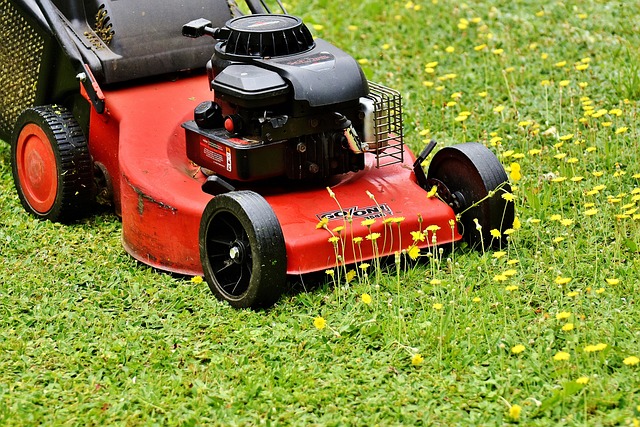Winter poses challenges to lawn health in South Dakota due to cold temps, snow, and soil inactivity. Proactive strategies like adjusted mowing, watering, fertilization, and insulation protect lawns from diseases & pests. Specific fertilization, snow removal, proper water management, pest control, and year-end care ensure vibrant grass come spring.
In South Dakota, winter presents unique challenges for lawn care enthusiasts. The extreme cold, snow, and varying temperatures can significantly impact grass health. This article guides you through the essential practices to ensure your lawn thrives during the colder months. From understanding winter’s effects to implementing targeted strategies for fertilization, pest control, and snow management, we offer a comprehensive year-end checklist tailored for South Dakota winters, ensuring your lawn remains vibrant and manageable throughout the season.
- Understanding Winter's Impact on Lawns in South Dakota
- Seasonal Transition: Preparing Your Lawn for Winter
- Protecting Grasses: Winter Fertilization Strategies
- Snow Removal: Maintaining Accessibility and Lawn Health
- Water Management: Conserving Moisture During Cold Months
- Pest Control: Identifying and Addressing Winter Pests
- Year-End Lawn Care Checklist for South Dakota Winters
Understanding Winter's Impact on Lawns in South Dakota

Winter can be a challenging season for lawns in South Dakota, with temperatures dropping well below freezing and snow covering the landscape. During this period, grass growth slows down significantly, and the soil becomes less accessible due to ice and heavy snowfall. The cold weather also makes it harder for grass to absorb water and nutrients from the soil, leading to dormancy. In addition, extreme temperature fluctuations can cause stress to the lawn, making it more susceptible to diseases and pests.
Understanding these impacts is crucial for homeowners and landscapers alike. Proper winter care involves adjusting mowing practices, ensuring adequate watering, and applying seasonal fertilizers to help lawns survive and thrive when conditions improve in spring. By taking proactive measures, South Dakotans can maintain healthier lawns that are better equipped to handle the unique challenges posed by their state’s winters.
Seasonal Transition: Preparing Your Lawn for Winter

As South Dakota’s weather begins to shift, it’s crucial to prepare your lawn for the winter season. This transition period is essential to ensure your grass enters dormancy safely and successfully. Start by assessing any remaining growth and removing dead vegetation. Next, fertilize your lawn to provide necessary nutrients that protect roots and promote healthy growth come spring.
Watering should be adjusted during this time; fewer waterings but deeper soakings will help establish a strong root system. Consider applying a protective layer of organic matter, like straw, to insulate the soil and prevent extreme temperature fluctuations. Additionally, clean your mower and store it properly to ensure it’s ready for next season. These steps will contribute to a vibrant lawn come spring.
Protecting Grasses: Winter Fertilization Strategies

Winter can be a challenging season for grasses, as colder temperatures and reduced sunlight slow down growth. To protect your lawn and ensure healthy grass come spring, incorporating winter fertilization strategies is essential. One effective method is to apply a slow-release fertilizer in late fall or early winter. These fertilizers provide nutrients gradually, ensuring your grass has a steady supply throughout the cold months.
Additionally, focusing on nitrogen-rich fertilizers can help maintain grass health. Nitrogen promotes lush growth, and while it may seem counterintuitive to add nitrogen during winter, it helps preserve the grass’s root structure. Remember to follow application instructions carefully and avoid overfertilization, as this can damage the lawn and potentially contribute to environmental harm.
Snow Removal: Maintaining Accessibility and Lawn Health

In South Dakota’s winters, snow removal is a vital aspect of lawn care, not just for accessibility but also for maintaining lawn health. While it might be tempting to let snow accumulate, especially in thick layers, doing so can suffocate grass and prevent essential sunlight from reaching the soil, hindering growth. Regular, efficient snow clearing ensures that your lawn receives adequate light and air, promoting a healthier, stronger grass in the spring.
Choose suitable tools for the job, like a reliable snow blower or shovel, to clear paths and driveways safely. Maintain these tools to ensure optimal performance, keeping them well-oiled and sharpened for easy, effective snow removal. By managing snow responsibly, you not only keep your property accessible but also contribute to the overall health and vibrancy of your lawn come spring.
Water Management: Conserving Moisture During Cold Months

In South Dakota’s cold winter months, proper water management is crucial for maintaining a healthy lawn. As temperatures drop, moisture evaporation slows down, but that doesn’t mean your lawn’s hydration needs diminish. On the contrary, deep watering less frequently can encourage roots to grow deeper, making lawns more resilient during dry spells. This method, known as “slow and deep,” ensures water reaches the root zone effectively.
To conserve moisture, homeowners should water their lawns early in the morning when temperatures are milder and winds calmer. This reduces evaporation loss. Additionally, applying a layer of organic mulch around the lawn can insulate the soil, slowing down moisture escape. These simple steps will help ensure your lawn stays healthy and vibrant even during the coldest months.
Pest Control: Identifying and Addressing Winter Pests

Winter can bring a unique set of pest challenges for lawn care in South Dakota. As temperatures drop, some pests become less active while others, like moles and mice, may become more prevalent. Identifying these winter visitors is crucial to maintaining a healthy lawn. Look for signs such as tunnels in the turf (moles), chewed stems or leaves (squirrels, deer), or visible damage from insects like chafers.
Addressing pest issues promptly is key. For moles and voles, consider repellents or physical barriers. If dealing with insect infestations, professional treatments may be necessary to effectively eliminate the problem. Regular inspections during the winter months can help in early detection, making it easier to control pests before they cause significant damage to your lawn.
Year-End Lawn Care Checklist for South Dakota Winters

As winter approaches South Dakota, it’s important to prepare your lawn for the colder months ahead. A year-end lawn care checklist can help ensure your grass remains healthy and vibrant come spring. First, remove any remaining debris, such as leaves and twigs, from your lawn to prevent them from smothering the grass during dormancy. Next, closely trim any hedges or shrubs to maintain their shape and allow for better air circulation, which is crucial for preventing fungal diseases in colder climates.
Additionally, consider feeding your lawn a winter-specific fertilizer to provide essential nutrients that support root growth and overall resilience against winter stress. Don’t forget to drain any outdoor watering systems thoroughly to avoid pipes freezing and damaging. Finally, mow your lawn one last time at a lower height to reduce snow accumulation and help prevent weeds from taking hold. These simple steps will go a long way in maintaining a healthy lawn that’s better equipped to withstand South Dakota’s winter conditions.
In the face of South Dakota’s winter challenges, proper lawn care can transform your yard into a resilient oasis come spring. By understanding the unique impacts of each season, implementing strategic preparations, and adopting tailored care practices, you can protect and enhance your lawn’s health throughout the cold months. This comprehensive guide offers practical insights to navigate the winter landscape, ensuring your lawn thrives when warmer days return.

